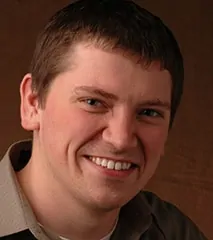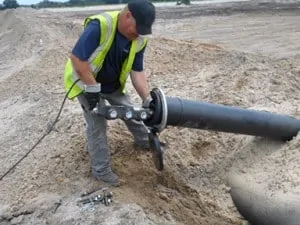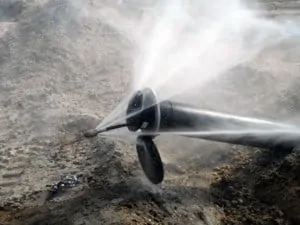

Landfill operators are making significant investments developing comprehensive lining systems to protect human health and the environment. These lining systems are normally equipped with drainage layers to convey leachate reaching the lining system to collection pipes and sumps for removal from the landfill. Landfill operators are also heavily investing in collecting and removing landfill gas for disposal or conversion to renewable energy.
After three decades of experience with these systems, landfill liquids may still accumulate in some gas wells adversely impacting gas removal efficiencies. In these situations installing a pneumatic submersible pump in the gas well to lower the liquid head in the well, restoring gas removal efficiencies is standard practice. However, this remediation technique requires additional capital investment.
An Alternative Solution Exists
A more recent alternative, constructing vertical drains from the bottom up where gas wells are located, may be a better solution. Construction of a vertical drain/gas well begins by constructing a gravel pad at the bottom of the landfill after completion of the lining system and placement of the protective soil cover over the lining system. The gravel pad may be 15 ft. by 15 ft. in lateral dimensions by 10 ft. in height. Gravel pads are normally constructed where future vertical wells are planned to be drilled. The center of each pad is surveyed, and the information is used to locate future gas wells at some vertical distance above waste that is placed in the new cell over time. The gas well drilling continues until it reaches the gravel pad at the bottom of the landfill. The connection between the gas well gravel pack and the gravel pad at the bottom makes it possible for landfill liquids to flow down and drain directly into the leachate collection system below the gas well.
Vertical drains help landfill liquids reaching the gas well gravel pack to flow to the leachate collection system at the bottom of the landfill; thus preventing watering out the gas wells. This sustainable alternative keeps gas production efficient and is environmentally sound, requiring less capital investment.
About the Author: Dr. Ali Khatami
More information about Liquids Management and Landfill Engineering
Related Advice, Whitepapers, and Articles
SCS Engineers’ Phillip E. Gearing, PE is a winner of the SWANA 2017 Young Professional Award from the Wisconsin Badger Chapter. The Solid Waste Association of North America honors individuals like Phil who make a significant difference in the solid waste industry.

Phil represents the best of the young professionals working within Wisconsin’s solid waste industry. Clients, contractors, and team members appreciate Phil’s leadership and passion for doing the job right.
He is a dedicated father of three children and an avid fan of all things Wisconsin, namely Badger sports, Green Bay Packer football, and Brewer baseball. Wisconsin from head to toe! Phil was raised on a dairy farm in Jackson County near Merrillan and attended the University of Wisconsin – Madison where he earned his B.S. in Geological Engineering, Geology, and Geophysics.
Phil serves clients out of the SCS Engineers office in Madison, WI.
Read about Phil’s work and SWANA award here.
The benefits of implementing these cleaning recommendations for leachate collection pipes will help keep the pipes clean and fully functioning; helping landfill operators prevent the potentially serious complications of clogged pipes and immovable leachate.
By Dr. Ali Khatami, P.E., SCS Engineers
Some states require that leachate collection pipes be cleaned with high-pressure jets on a regular basis (for example, every ten years or even more frequently); however, the rules don’t clarify or set forth the specific conditions under which the jet cleaning should be performed. Some landfills have undertaken jet cleaning while the pipes are partially or fully submerged in leachate above the liner. Unfortunately, jetting under water may drastically reduce the effectiveness of the pressurized jet, resulting in a pipe that is not cleaned properly. This is even more important when the jetting is intended to remove biological growth on the pipe walls and in the perforation openings.

In addition, many states do not require videotaping the pipe after jetting. Videotaping is the best way to verify that the pipe was cleaned successfully. If the leachate collection pipes are not properly cleaned, then over a period of 20 years or so, they can be adversely impacted by severe biological growth and buildup in the pipe perforations to the point that liquid can no longer enter the pipe.
Another shortcoming is that the rules do not specifically require that the riser pipes (where the submersible pumps are located) be cleaned or videotaped. Therefore, due to the added costs, some landfill operators may not clean the riser pipes as part of the required cleaning events, or they may delay such cleanings for an extended period. This can prevent leachate from flowing into the riser with the direct and serious consequence that leachate cannot be removed from the sump.

Another issue to consider is that pressurized jet cleaning procedures do not necessarily push the solids that separate from the pipe wall out of the pipe inlet opening through which the cleaning nozzle entered the pipe. As a result, these solids flow out of the pipe and into the gravel bedding on the outside of the pipe, and can potentially clog the void within the gravel pack around the pipe or in the sump. Clogging the sump gravel can mean reduced flow capacity from the leachate collection pipe to the riser pipe and the submersible pumps.
To resolve these issues, SCS recommends the following:
The benefits of implementing these recommendations will help keep the pipes clean and fully functioning. These suggestions help prevent potentially serious complications that the landfill operator may have to address if the pipes are clogged and leachate cannot be removed.
Questions? Contact Ali Khatami, PhD, PE, LEP, CGC, is a Project Director and a Vice President of SCS Engineers. He is also our National Expert for Landfill Design and Construction Quality Assurance. He has nearly 40 years of research and professional experience in mechanical, structural, and civil engineering. Dr. Khatami has acquired extensive experience and knowledge in the areas of geology, hydrogeology, hydrology, hydraulics, construction methods, material science, construction quality assurance (CQA), and stability of earth systems. Dr. Khatami has applied this experience in the siting of numerous landfills and the remediation of hazardous waste contaminated sites.